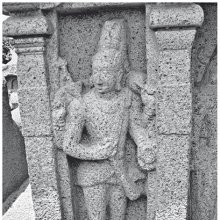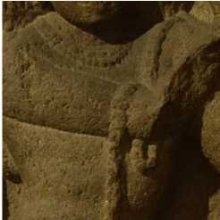Kankalamurti, Kaṅkālamūrti, Kankala-murti: 3 definitions
Introduction:
Kankalamurti means something in Hinduism, Sanskrit. If you want to know the exact meaning, history, etymology or English translation of this term then check out the descriptions on this page. Add your comment or reference to a book if you want to contribute to this summary article.
Images (photo gallery)
In Hinduism
Shilpashastra (iconography)
Source: Wisdom Library: Śilpa-śāstraKaṅkālamūrti (कङ्कालमूर्ति) refers to an image (mūrti) of an aspect of Śiva. Kaṅkāla literally means “a skeleton”. The Pūrva-kāraṇāgama states that the figures of Śiva in the kaṅkāla-mūrti aspect should not have near them the figure of the Devi. The colour, according to the Kāraṇāgama, of the kaṅkāla-mūrti aspect of Śiva is to be white.

Shilpashastra (शिल्पशास्त्र, śilpaśāstra) represents the ancient Indian science (shastra) of creative arts (shilpa) such as sculpture, iconography and painting. Closely related to Vastushastra (architecture), they often share the same literature.
Shaivism (Shaiva philosophy)
Source: Shodhganga: Iconographical representations of Śiva1) Kaṅkālamūrti (कङ्कालमूर्ति) or simply Kaṅkāla refers to one of the twenty-three forms (mūrti) of Śiva mentioned in the Pūrvakāmikāgama (pratimālakṣaṇavidhi-paṭala): first and foremost among the Mūlāgama. The forms of Śiva (e.g., Kaṅkāla-mūrti) are established through a process known as Sādākhya, described as a five-fold process of creation.
2) Kaṅkālamūrti is also listed among the twenty-eighth forms (mūrti) of Śiva mentioned in the Vātulāgama: twenty-eighth among the Siddhāntaśaivāgama.
3) Kaṅkālamūrti is also listed among the eighteen forms (mūrti) of Śiva mentioned in the Kāraṇāgama (pratimālakṣaṇavidhi-paṭala): the fourth among the Siddhāntaśaivāgamas.
4) Kaṅkālamūrti is also listed among the eighteen forms (mūrti) of Śiva mentioned in the Śilparatna (twenty-second adhyāya): a technical treatise by Śrīkumāra on Śilpaśāstra.

Shaiva (शैव, śaiva) or Shaivism (śaivism) represents a tradition of Hinduism worshiping Shiva as the supreme being. Closely related to Shaktism, Shaiva literature includes a range of scriptures, including Tantras, while the root of this tradition may be traced back to the ancient Vedas.
General definition (in Hinduism)
Source: Shodhganga: Historical setting of the vaisnava divyaksetras in the southern pandya countryKaṅkālamūrti (कङ्कालमूर्ति).—The Lord who bears the kaṅkāladaṇḍa is known as kaṅkālamūrti. It is a sectarian form that exalts the greatness of Śiva beca use the kaṇkāladaṇḍa that he carries is supposed to be the remnant of the daśāvatāras of Viṣṇu. It is also supposed to be the mortal remains of Trivikrama. Others consider it a skeleton. It is also supposed to be a musical instrument called kaṅkāla.
See also (Relevant definitions)
Partial matches: Murti, Kankala.
Full-text: Bhikshatana, Kankala.
Relevant text
Search found 8 books and stories containing Kankalamurti, Kaṅkālamūrti, Kankala-murti, Kaṅkāla-mūrti; (plurals include: Kankalamurtis, Kaṅkālamūrtis, murtis, mūrtis). You can also click to the full overview containing English textual excerpts. Below are direct links for the most relevant articles:
Sculpture at its Best < [September-October, 1929]
The Religion and Philosophy of Tevaram (Thevaram) (by M. A. Dorai Rangaswamy)
Chapter 4.1 - Bhikshatana-murti (the Lord becoming a beggar) < [Volume 2 - Nampi Arurar and Mythology]
Symbology of khatvanga in the Mahavrata < [Volume 2 - Nampi Arurar and Mythology]
Chapter 4.6 - (i) Symbology of the serpent and worship < [Volume 2 - Nampi Arurar and Mythology]
Middle Chola Temples (by S. R. Balasubrahmanyam)
Temples in Tiruppudaimarudil < [Chapter II - Temples of Rajaraja I’s Time]
Temples in Tirunelveli < [Chapter II - Temples of Rajaraja I’s Time]
Temples in Tiruchchengattangudi (Sri Uttarapatisvarar Temple) < [Chapter II - Temples of Rajaraja I’s Time]
Kashyapa Shilpa-shastra (study) (by K. Vidyuta)
7. Favourable Directions for Installing the Śiva Mūrtis < [Chapter 3 - Prākāra Lakṣaṇa]
Cosmetics, Costumes and Ornaments in Ancient India (by Remadevi. O.)
2.5. Various other Hand Ornaments < [Chapter 3 - Ornaments]
Early Chola Temples (by S. R. Balasubrahmanyam)
Temples in Karuntattangudi (Karandai) < [Chapter VIII - Temples of Uttama Chola’s Time]
Devakoshta < [Chapter XIII - Prasada: Component Parts]
Temples in Tirumananjeri < [Chapter VIII - Temples of Uttama Chola’s Time]

